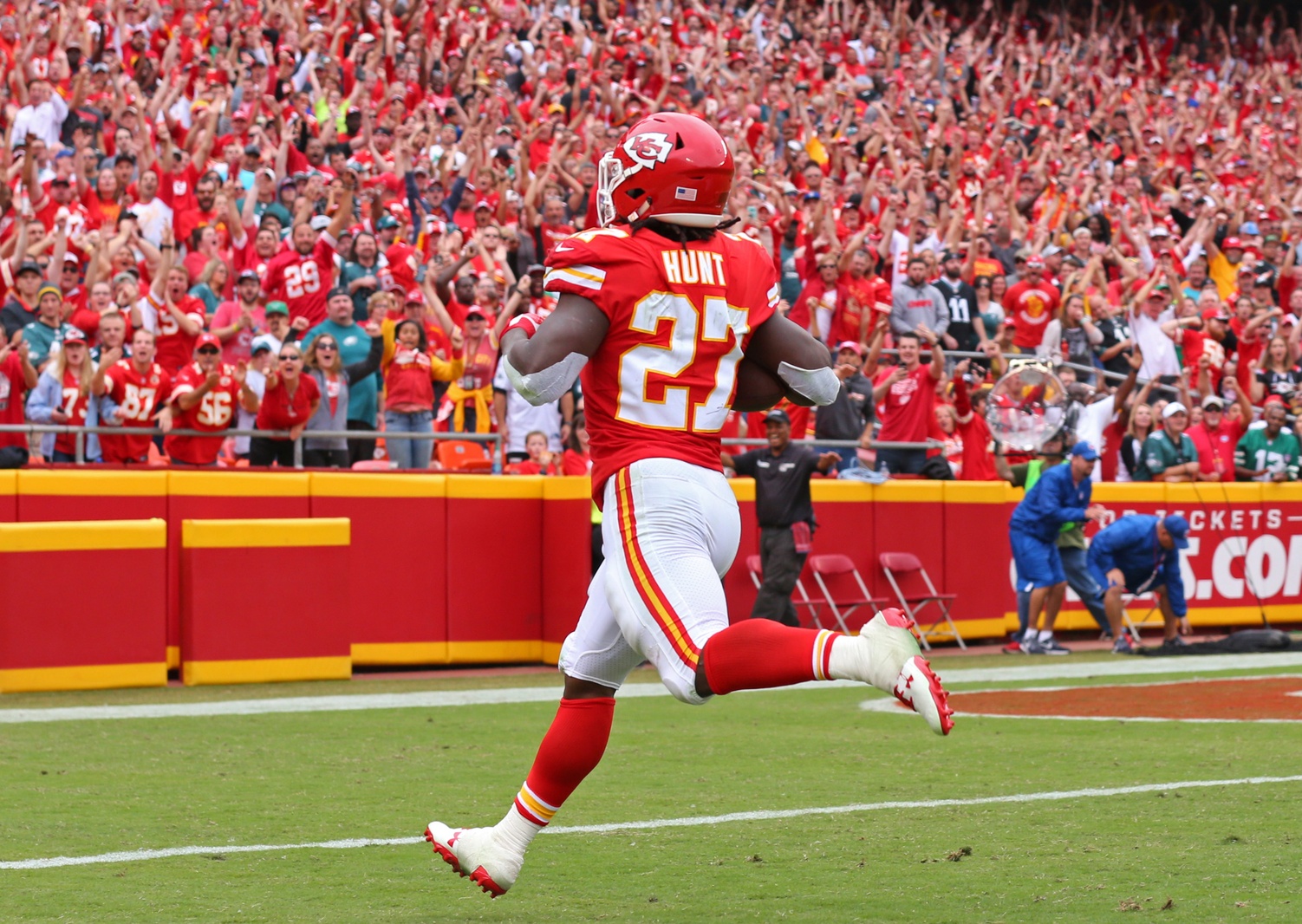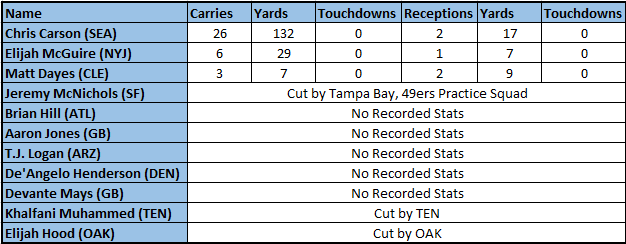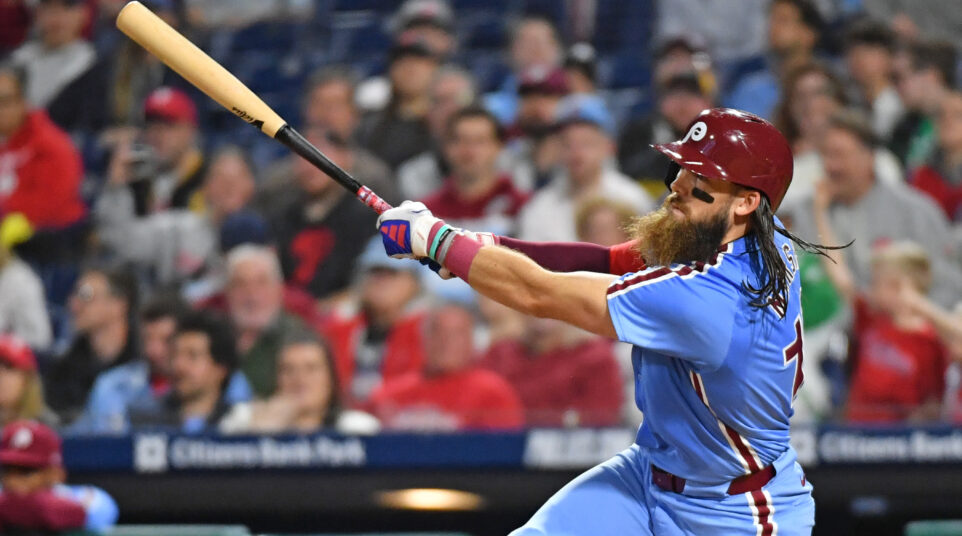
The Eagles Didn't Draft a Good Running Back, but Everyone Will Survive
The Eagles’ running game has been the topic du jour since the Birds traded for Ronald Darby and partially fortified their undermanned secondary. We deviated for a day or so to bitch about screen passes, but now we’re right back to square one.
Much of the debate focuses on why the running game is struggling – lack of called running plays, poor offensive line play, lack of decent running backs, etc.
As an aside, I am firmly in the “running game is fine, you just need to actually run the ball” camp. Most of the offensive line, from an individual talent standpoint, is a known quantity. The Eagles have had success running behind these guys in the past.
As for the running backs, Darren Sproles is obviously not an issue, Wendell Smallwood has shown he can at least be effective in spurts, and LeGarrette Blount is a nine-year NFL veteran. You don’t play nine years in the NFL with no running ability. I honestly believe that the answer is giving them more opportunity and some patience. In other words, trade everyone to New England!
I don’t want to talk about the actual running game, though. That topic has been analyzed and debated ad nauseam.
I want to discuss another topic that has spurred a lot of recent debate: the Eagles walking away from a “historic” running back class with nothing but a 5’8”, 176-pound change of pace.
With the recent running game struggles, and the early success of rookies like Kareem Hunt and Tarik Cohen, the masses have taken those events, rolled them into a half-baked narrative about the Eagles leaving the draft with only Donnel Pumphrey, and are now passing it around for everyone to take a hit.
Here’s why that’s wrong.
Defining A “Historic” Class
Once or twice a year, Howie Roseman makes a comment that ends up haunting him forever. Calling the 2017 running back draft class “historic” was one of them. These quotes tend to make for good storylines but are often taken too literally or way out of context.
There’s no doubt that this was a good rookie class. In fact, it probably does actually qualify as historic, but only because it was full of players who could potentially stick on an NFL roster. It doesn’t mean that every running back in the class will end up being great, or even good for that matter. Just like every other draft class, there were potential stars at the top and then a bunch of spare parts further down the pecking order.
Beyond the top players, some, like Alvin Kamara, were good in the passing game, but questionable elsewhere. Others, like Corey Clement, were decent running between the tackles, but didn’t have the athleticism to be every-down players. Then there were players like Jamaal Williams, who had a well-rounded skill set but lacked the overall explosiveness and athleticism to warrant high draft investment.
Let’s just slow down on the “historic class” narrative. It was taken out of context. The reality is, the Eagles would’ve had to spend significant draft capital to get anything more than the second coming of Wendell Smallwood, not to mention the opportunity cost of leaving other, more critical positions weaker.
Now that the running game is struggling, it’s officially time to use our 20/20 hindsight to determine who the Eagles should have drafted.
Here are all the running backs the Eagles missed out on in the draft and the players they took instead pic.twitter.com/iS4cgUHE9b
— Jon Marks & Ike Reese on 94WIP (@MarksReeseWIP) September 19, 2017
Let’s dissect this list…
The Early Rounds
I’ll start by saying that I can completely understand anyone who preferred Dalvin Cook or Joe Mixon to Sidney Jones. By all accounts, the Eagles wanted Cook over Jones, too. While perhaps slightly disappointing, that decision is at least defensible.
Jones was considered by many to be the top cornerback prospect pre-injury and the Eagles were in desperate need of help there. Questions obviously surround his health, but in today’s NFL, as we’re now seeing with Ezekiel Elliot, the character concerns that Cook and Mixon presented were no less problematic.
The real debate, for reasons that I cannot understand, is with the Rasul Douglas pick. Some want to retroactively select future hall of famer Kareem Hunt with this pick. That would prove difficult, of course, given that Hunt was off the board 13 selections earlier!
More realistically, the Eagles actually could have passed on Douglas and drafted another running back like the human joystick, Tarik Cohen, but there are a few major flaws with that idea too.
First, I don’t think there’s much debate as to what the Eagles biggest need was heading into the draft. Jalen Mills was the best and most experienced corner on the roster. 94 WIP and 97.5 the Fanatic were flooded with complaints about the gaps in the secondary. Imagine, for a second, the Eagles taking a running back in the third round and heading into the third day of the draft with only one cornerback in tow, one who probably wasn’t even going to play in 2017. There would have been a revolt in the streets! Draft Town would have been turned completely on it’s head!
Secondly, Cohen is all the rage now, but I must’ve missed the clamoring for him back in April. What I didn’t miss, however, was the uproar over drafting a certain 176 pound running back and the barrage of statistics showing how unlikely it is for him to succeed in the NFL. Cohen was only three pounds heavier than Pumphrey. Are we going to pretend there wouldn’t have been the same uproar over Cohen? We can’t have our cake and eat it too.
Some have also proposed that the Eagles could’ve traded up from 99 to select Hunt.
In other words: Eagles easily could have traded 99, 139, and 230 to get Kareem Hunt.
— Brandon Lee Gowton (@BrandonGowton) September 8, 2017
Again, imagine heading into the third day still searching for a cornerback, then subtract two more draft picks from which to find said cornerback. There was context to the situation. We can’t just completely ignore it out of convenience.
Lastly, when considering the value of a good cornerback versus that of a running back, the decision is a no brainer. One position is infinitely more important than the other and it’s clear that the Eagles understood that.
The Later Rounds
Potentially whiffing on the Pumphrey pick is a tough pill to swallow, no doubt, and it looks like a bad pick. But let’s not pretend, that by selecting Pumphrey, the Eagles missed out on some potential game-changer. There’s a reason that these players were around in the fourth of seven rounds. They’re just guys.
After the draft, many were upset that the Eagles took Pumphrey over Williams, Marlon Mack or Wayne Gallman. Let’s take a quick peek at how these players are doing so far in their rookie seasons:
Four carries for 15 yards. Fire emoji.
Whew. Imagine how dynamic Eagles offense could be with another 1.3 yards per carry in their stable?
The Giants have one of the worst rushing attacks in the league, yet Gallman has been a healthy scratch for both games. I’m sure he’s about to break out though.
What about the other backs drafted after Pumphrey? How are they doing?
Obviously the one that stands out is Chris Carson, who has gotten off to a great start. To be clear, Carson was selected with pick 249 in the seventh round. Other teams, Eagles included, passed on him 248 times, for good reason I’d have to think. It’s hard to fault the Eagles on this one. If any team had a clue that Carson would be any good, he would’ve been selected much sooner than the seventh round.
Aside from Carson, explain to me how any of these other players could provide the Eagles with anything more than what Clement, an undrafted free agent, provides them right now.
The Eagles could certainly have gone in another direction early in the draft, but there were a lot of needs to fill. All things being equal, investing in pass rushers and cornerbacks should always take precedent over a running back. Even if you would have preferred the Eagles take a runner, their strategy has to at least be somewhat understandable.
Regardless of what kind of player Donnel Pumphrey turns out to be, the idea that the Eagles’ 2017 draft was a complete failure is simply not true.









